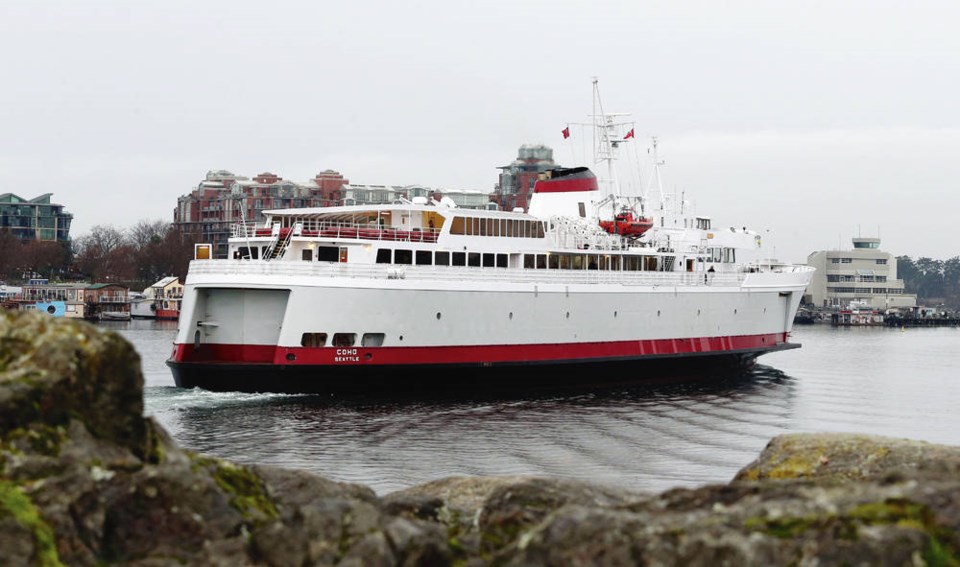Greater Victoria’s vital tourism link with the United States took another blow Friday when the United States extended its closure of the marine border until at least Sept. 21.
That means the MV Coho vehicle ferry from Port Angeles and Clipper passenger service from Seattle remain in limbo as the summer season slips away.
“It’s disappointing, but not unexpected,” said David Gudgel, chief executive of Clipper Navigation. “We’re still hopeful we can get both sides open soon.”
The announcement, from the U.S. Department of Homeland Security, extends the ban on non-essential travel at both land and ferry crossings — the first such extension since Canada welcomed vaccinated Americans back into the country this month.
It came a day after Prime Minister Justin Trudeau said at an election campaign stop in Victoria that the marine border would remain closed because “we don’t have the capacity to manage it safely.”
Ryan Burles, chief executive of the Black Ball Ferry Line that operates the Coho, said Friday the company is “patiently awaiting” policies about restarting on both sides of the border.
Gudgel said the Clipper had initially planned to be operating by Labour Day, but those plans have been dashed. The Canadian rules are essential for the Clipper because about 85% of its usual customers are Americans going north.
It’s a more of an even split for the Coho, with about 40% of its passengers Canadians heading south.
Both the Clipper and Coho have been docked since the pandemic began, although the Clipper is running limited whale-watching excursions to the U.S. San Juan Islands.
Gudgel said the Clipper is prepared to pre-screen passengers, just as the airlines are doing, and has always provided a designated space in its terminal for Canadian border officials to pre-screen passengers on arrival.
He said discussions with Canadian Border Services Agency have been ongoing since Monday, but it’s unclear whether the capacity issues involve technical issues around testing and screening or staffing issues, or both.
“We’ve been trying to get clarity on that all week, so it’s somewhat frustrating,” said Gudgel.
The U.S. borders will remain closed to non-essential travel out of concerns about the Delta variant of the COVID-19 virus, the U.S. Department of Homeland Security said in a tweet.
“To minimize the spread of [COVID-19], including the Delta variant, the United States is extending restrictions on non-essential travel at our land and ferry crossings with Canada and Mexico … while continuing to ensure the flow of essential trade and travel,” it said.
The restrictions, in place since March 2020, were set to expire today.
The U.S. allows Canadians to fly across the border for non-essential purposes, but only a select number of Canadian airports are currently equipped to handle them. Victoria International Airport is not among the approved airports, further squeezing the tourism sector.
The 17-month-long ban on non-essential travel across the Canada-U.S. border was eased by the Canadian government on Aug. 9.
Canada currently allows U.S. citizens and permanent residents into the country, provided they’ve been fully vaccinated against COVID-19.
Eligible visitors to Canada must live in the U.S. and have allowed 14 days to pass since receiving a full course of a Health Canada-approved vaccine.
They are also required to show proof of a negative molecular test for COVID-19 that’s no more than 72 hours old and use the ArriveCAN app or online web portal to upload their vaccination details.
U.S. citizens on pleasure craft are allowed to enter Canada without pre-screening, but have to provide proof of vaccination and a negative COVID test after arriving at designated marinas in Canada.
Trudeau said this week: “We are working to increase that [marine border] capacity and hope to see positive things come in the not-too-distant future.”
Canada will reopen marine borders to cruise ships on Nov. 1, and ferry operators are assuming that will also apply to them.
The lopsided policy has rankled observers.
Destination Victoria chief executive Paul Nursery said U.S. ferries bring in 750,000 visitors to Victoria every year and those passengers book about 1,400 hotels rooms a month. He said international visitors arriving at the Belleville Street terminals brought in about $100 million.
The U.S. ferries say they need rules and procedures clearly defined to ramp up their operations.
“It’s getting to be crucial time to make a decision to restart or mothball until spring,” said Gudgel.
He said Clipper Navigation is hopeful it can salvage a shoulder season with Americans who find good hotel rates in Victoria, and Canadians who want to take advantage of the debut season of the NHL’s newest team, the expansion Seattle Kraken.
— With files from The Canadian Press and Vancouver Sun



